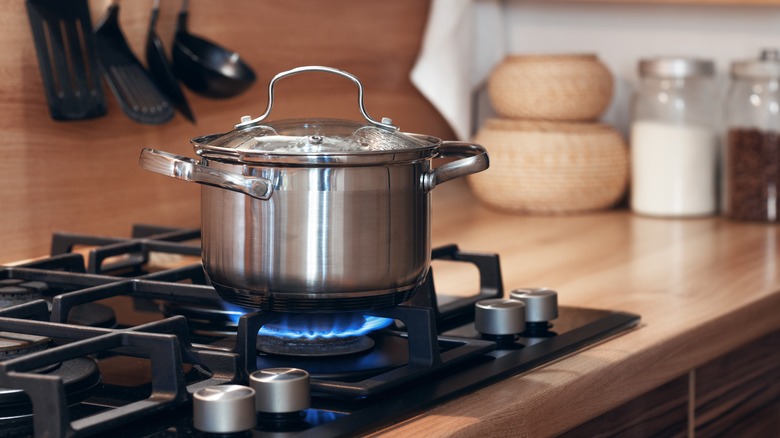The gas stove has been a kitchen staple for decades. Traditionally preferred over electric stoves by home cooks and professional chefs alike, gas stoves immediately conjure the image of a well-cooked meal. This essential kitchen appliance uses gas, commonly natural gas or propane. When the gas is mixed with air and ignited, it produces a flame. A valve regulates the flow of gas, which can be controlled and adjusted by turning the burner knobs.
This process creates an even, easily manageable distribution of heat to the stove-top burners, which makes it a tried and true favorite for foodies. Burners on gas stoves heat up much faster than that of electric stoves, which is great for chefs but can be dangerous to you and your food without the proper knowledge. The open flame of a gas range can be daunting to the inexperienced, but these cooking tips can help you elevate your skills and cook safely.
Start low and slow
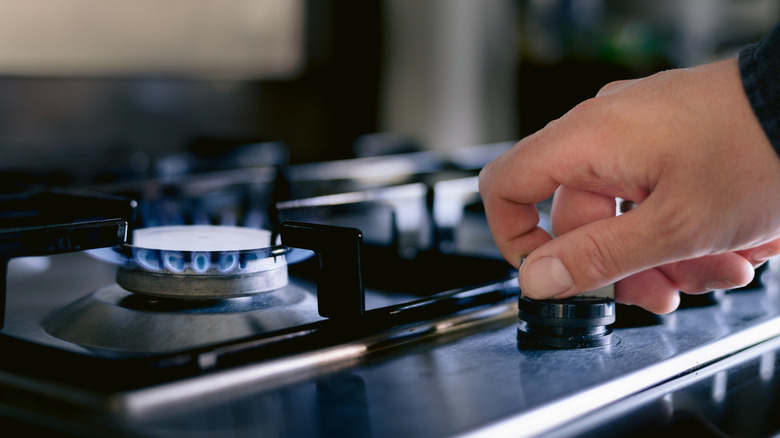
Balancing the heat of a gas stove can be a bit of a dance. When starting out, you might find yourself turning the knob from left to right, trying to find the perfect balance so you don’t overcook your meal. Electric stoves take a few minutes to heat up, but heat from the open flame occurs almost instantly. To a beginner, it can be easy to heat things too quickly which can lead to ruined food.
Luckily, gas stoves provide a simple visual reference: the flame, making it easy to adjust the temperature. It is best to start with a smaller flame and increase as necessary in order to get used to the feel of the fire. In this situation, the old adage of practice makes perfect really rings true. There will inevitably be a bit of trial and error, but hopefully, after using a gentle flame and cooking a few dishes you’ll have your preferred cook temps dialed in.
Ventilate your cooking space
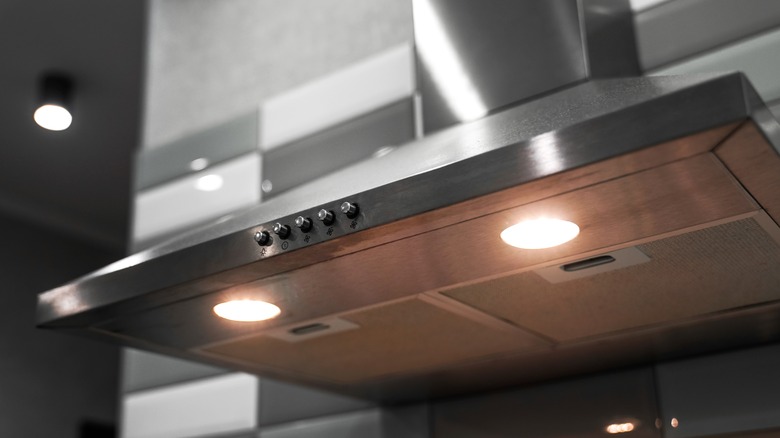
Gas stoves have been in the news in 2023 for the harmful gasses they release. Don’t worry though, this can be mitigated by having a well-ventilated cooking space. The gas stove range hood plays a bigger role than you might expect when it comes to kitchen safety. When the flame of a gas stove is ignited, byproducts like carbon monoxide and nitrogen dioxide are released into your kitchen space, according to Stanford Medicine.
These byproducts can be harmful over time, but the range hood helps funnel these gasses away from your cooking space so you can fry, boil, and sauté to your heart’s content. If you have a range hood, make sure to use it every time you cook, and if you’re without, opening a window and using a fan will make sure you get fresh air in. An air purifier is a great additional step to help ensure those harmful gasses are neutralized.
Be specific with your pans
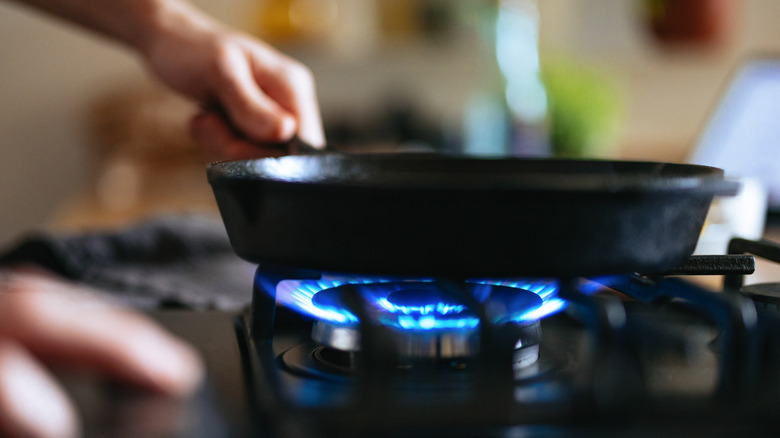
Miniseries/Getty Images
The quick heating time of gas ranges is great for searing and sautéing, but it’s important to use the right pan for the job. Stainless steel pans are great for almost every recipe. They heat up quickly and are durable pans for everyday use. They also are easy to clean, which gives you more time to relax after a good meal. People get worried about using cast iron and stainless steel because they don’t have nonstick coatings. However, when using these pans on gas stoves, you can adjust the heat more easily creating the perfect balance for a dish without dealing with any sticky bits left over.
A cast iron pan will reap more of the benefits of a gas stove than something like your standard nonstick. That’s because a cast iron retains heat extremely well allowing you to get a perfect sear on steak, fish, and chicken. Those who want to make authentic stir fry at home should invest in the best wok available to them. Woks are traditionally used on a live flame making them perfect for your home gas stove.
Pick the right burner
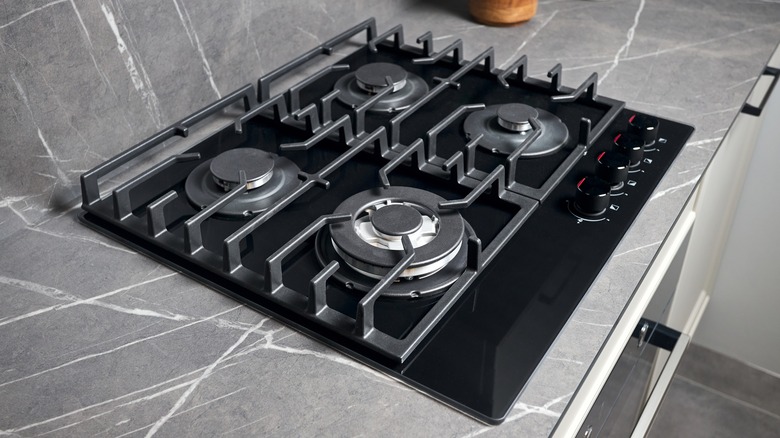
RYosha/Shutterstock
A standard gas range has three to four different sized burners ranging from small to large. Some even have a center burner that comes with a griddle pan. When boiling a pot of water or pan frying some veggies, choosing the right burner for the job can make all the difference.
The smallest burner on the stove is called the simmer burner. Simmer burners are good for smaller sauce pans and can be used for heating up soup or melting butter. The medium sized burner on the stove is known as an all-purpose burner. It does the job for most day-to-day cooking activities, like sautéing or pan frying. This burner will likely get a lot of use. The largest burner, known as the power burner, can reach extremely high temperatures in comparison to the simmer burner. The high heat of the power burner lends itself nicely to searing or boiling a large pot of water.
Some stovetops come with a long burner in the middle called an oval burner. This is great for using griddle plates or heating up larger cooking pans. The dual-ring burner is another variation of burner that is included in some gas ranges. With the dual-ring burner, there is a small burner plate in the middle with a larger exterior ring, allowing for greater temperature adjustment. This works well for recipes with multiple steps and techniques. For instance, an old-fashioned beef stew often requires both sautéing and simmering, which can be achieved with the dual-ring burner.
Use the burner to roast on an open flame
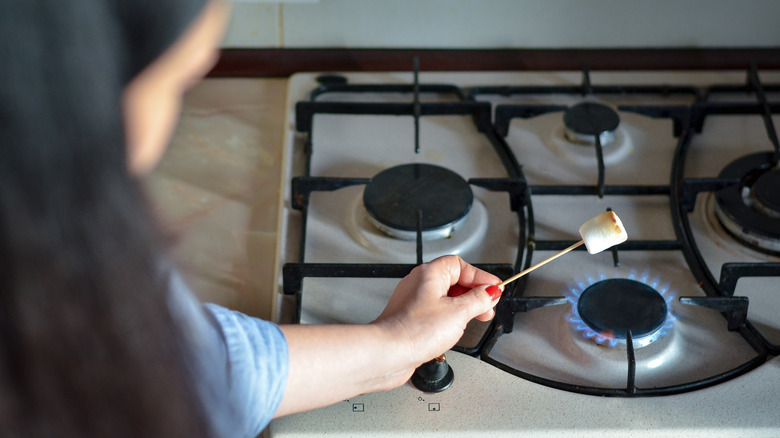
Vitaliy Kyrychuk/Shutterstock
Roasting on an open flame is a surefire way to get that smoky charred flavor into your meal. If you are without a grill, or it’s a little too cold to go outside, using a gas oven burner is a great substitute that will ensure a perfect char and complex flavor profile in your dish. Whether it’s roasted bell peppers or some charred corn on the cob, placing these veggies directly onto the high flame of a gas stove burner will cook the interior and give a nice darkened crust on the skin.
When roasting veggies or charring tortillas on the gas burner, make sure to use tongs and rotate whatever is cooking to get an even char. Tongs are necessary to minimize hand contact with any hot surfaces or ingredients and to maneuver the food being charred more efficiently.
However, the gas stove flame can be used for more than just a simple char. It can be used for hands-on activities the whole family can partake in — with supervision of course. Skewering marshmallows and roasting them on the burner flame will give you the perfect s’more without the hassle of building a fire outdoors. Using long skewers and rotating it whilst cooking will ensure safety from the flame and a lovely golden crust on the marshmallow. There are endless possibilities when it comes to skewer roasting over a flame. You can even roast hot dogs over a gas burner if you are craving that smoky flavor.
Prep your ingredients in advance
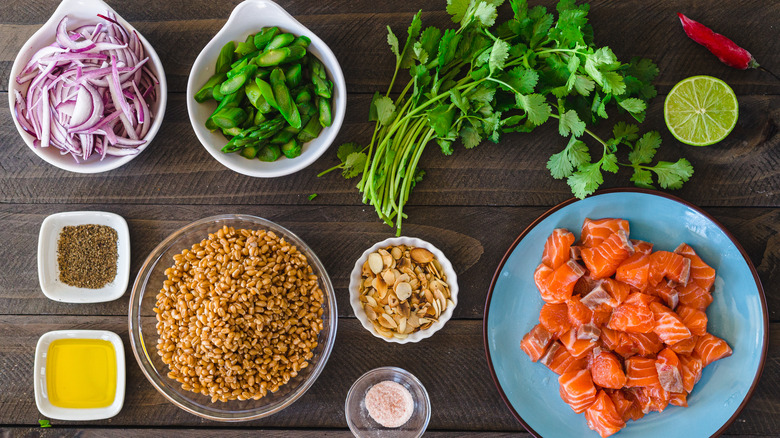
Luca Melo/Getty Images
When cooking with a gas stove, the burners heat up significantly faster than those on an electric stove. With an electric stove, ingredient prep like chopping an onion or garlic can be done while the stovetop is heating. With gas stoves, if the burner heats up during prep, there’s a risk of the pan overheating, which could lead to burnt food and sticky bits on the pan.
It’s better not to feel rushed when cooking a meal. In the culinary world, there is a French term called “mise en place” which translates to “everything in its place.” Mise en place is the act of preparing ingredients and organizing the workspace before cooking. Assembling your mise en place in advance is a good habit to get into so that the cooking process can go smoothly and any road bumps can be solved.
Professional chefs often emphasize the importance of ingredient preparation before cooking, so if you’re cooking at home, it’s a good rule to follow. For gas stoves, and cooking in general, mise en place is the way to go.
Avoid cooking in loose clothing

Dzha33/Shutterstock
Working with open flames can produce phenomenal food, but all heat sources require safety measures to avoid any unwanted burns or incidents. When cooking a large meal it can become a bit hectic, especially if multiple burners are being used simultaneously.
There are moments where you might need to reach over a pan to stir something on the backburner, or just simply to take it off the heat. When cooking with fire, flames can occasionally peek out from beneath the pan, and there is a potential for dangling or loose clothing to ignite or get caught on panhandles. A loose sleeve caught on a handle could cause the pan to drop and potentially hot food to spill.
Most home cooking fires involve gas range stove tops, according to FDNY Smart. Even if you have familiarity with cooking on a gas range, it is crucial to always remain aware of where you are adjacent to the flame. Wearing tight-fitting clothes while cooking minimizes the risk of any potential accidents so you can cook safely to your heart’s content.
Listen for clicking
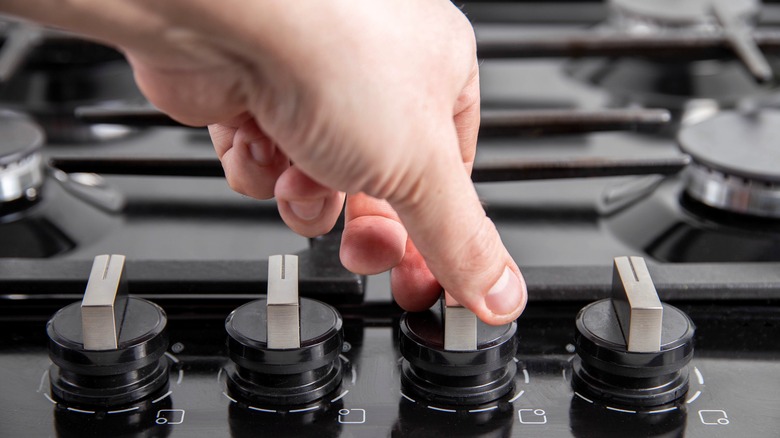
HenadziPechan/Shutterstock
Hearing a repetitive clicking noise without seeing a flame means there is an issue with the stove’s ignition. It can be a frustrating setback to meal prep when the stove doesn’t ignite, but don’t give up yet. In most cases this can be resolved quite easily.
There are a variety of reasons for slow ignition, or no ignition at all. Some are as simple as having dirty or wet burners. Occasionally after cleaning the stovetop, water can make its way into the burner head ignition. This might cause clicking when the burner knob is turned, because the ignition is too moist to light. To solve this, simply wait for the burner head ignition to dry.
Another potential reason for clicking is that the burner caps themselves are placed incorrectly on the stove. After cleaning off burner caps, it can be tricky to put them back into position. If the caps seem tilted slightly, they are not properly placed. When placing them back onto the rest of the burner, it will feel like locking in a puzzle piece. When the cap feels snug in place, make sure it lays perfectly flat.
Most importantly, if you are turning the knob and the stove is not igniting, turn off the knob and wait for the gas to dissipate before attempting to ignite again. Even if a flame isn’t visible, gas is still being released while the knob is turned on.
Keep your stove clean
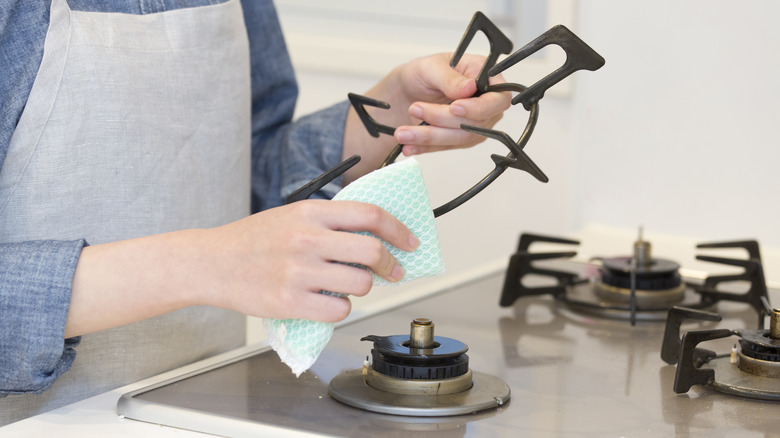
West/Getty Images
Maintaining a clean gas range is crucial to maximize efficiency and preserve food quality. A well-used stove will inevitably fall victim to splashes, splatters, and forgotten burnt bits. It happens to the best of us. Cleaning a gas stovetop can be a daunting task. There are all sorts of nooks and crannies where food remnants find their way, so it’s a bit more complicated than simply wiping off the surface of an electric stove.
However, it is important to clean gas stove tops regularly to maintain a safe cooking environment. Holding off on proper stove maintenance can affect the effectiveness of the stove itself and could result in uneven heating distribution from the flames.
When cleaning the stovetop, remove the cooking grates and burner caps and soak them in soapy water. This is a great first step to help loosen some of those burnt sauce spots or caked-on spills. For harder-to-clean grates and burner caps, Whirlpool suggests using a mixture of baking soda and water to create a paste. This acts as an effective, stovetop safe cleaning alternative that will pick up any leftover residue. Other cleaning products can be used, but it’s important to research cleaning products that will be compatible with your stovetop as some chemicals can be damaging to a gas stove.
Keep oven mitts handy
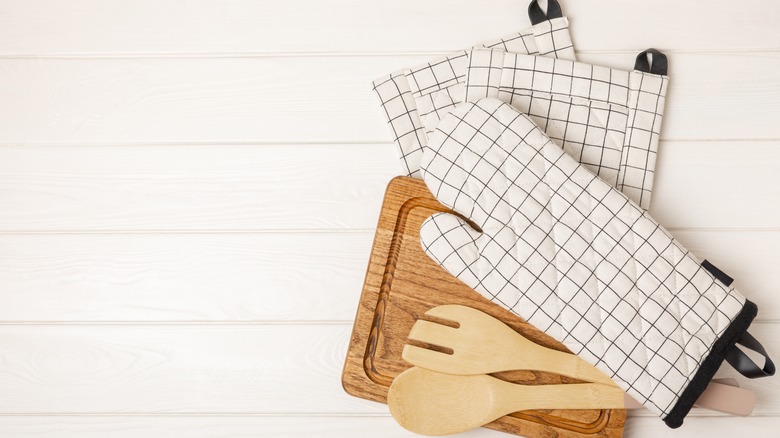
Avocado_studio/Shutterstock
When cooking on gas burners, there will be times when the flame wraps around the bottom of the pan. If the pot or pan is smaller than the burner, or if the flame is set too high, this is likely to happen. When this occurs, not only will the bottom and sides of the pan become hot, the handles of the pan will too.
It can be second nature to reach for the handle of a pan when the food is done or needs a good shake. Confidently grabbing a scorching hot handle is never the cooking experience anyone wants. Keeping oven mitts or pot holders in close reach can help to mitigate these instances.
Oven mitts are an essential cooking tool for any home chef, novice and expert alike. It is important to keep oven mitts nearby to avoid nasty burns, but keeping them too close to the flame could cause a fire. Using an oven mitt hook or making sure to keep them at arm’s length from the flame are ways to mitigate those risks.
Have a lighter or matches available
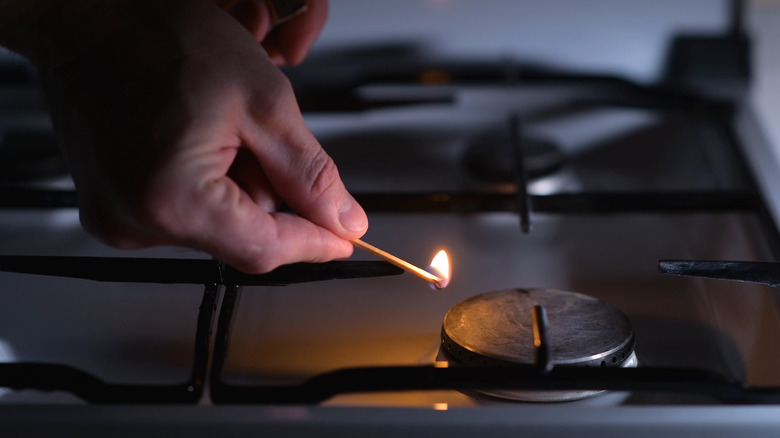
Slava Dumchev/Shutterstock
In the event of a power outage, it might seem that all is lost and that the bag of chips in the cupboard is all there is to sustain you. The refrigerator won’t work. The microwave won’t work. Any electrical appliance becomes obsolete, but hope is not lost.
Most people don’t realize, but since a gas stove uses natural gas rather than electricity, it can still be used in the event of a power outage. The flames may not come out when the knob is turned. That’s because the automatic ignitor needs electricity to run. Even still, the burners can be ignited manually. It just takes a lighter.
To manually ignite gas stove burners, it is important to practice caution and have the burner knob set to low. Less gas will be released, minimizing the size of the flame once ignited. A matchstick can be used to light the flame, but something longer like a candle lighter is better suited so there is more distance from the burner itself. It is important to stay aware of the burner knobs, because if the manually ignited flame blows out, gas will still be released into the kitchen. Turning off all knobs will stop the flow of gas.
Increase efficiency with a griddle
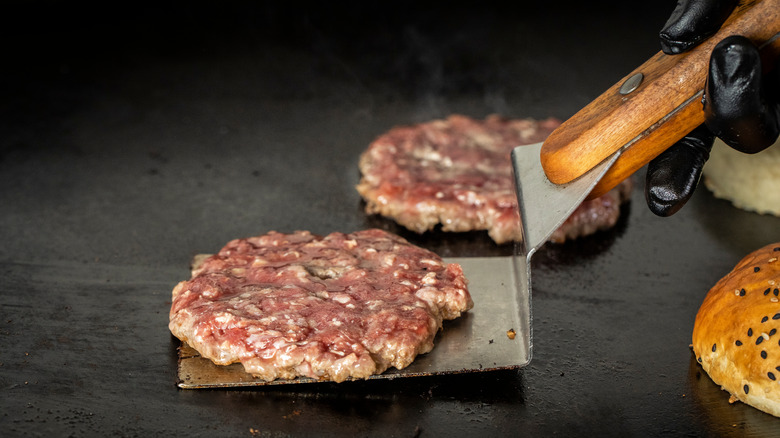
salcover/Shutterstock
A griddle is a flat metal plate that can be laid over gas oven burners. It allows for an even distribution of heat across a larger surface than a standard range burner. Most gas ovens come with a griddle. Rather than putting it in a drawer to be forgotten, make the most of this stovetop accessory to impress family and friends.
Griddles are a great choice when cooking for large groups, because they increase cooking space, allowing for multiple dishes to be cooked at once. There’s a reason restaurants opt to use griddle style plates in that it provides consistent heat on a large cooking surface. The heat retention of the griddle makes it an optimal choice for making restaurant-quality smash burgers or for cooking a full breakfast. Cooking pancakes, bacon, and eggs on the griddle plate will have breakfast done quickly without the hassle of scrubbing multiple pans. Plus, there will be far less cleanup when you’re all done.



